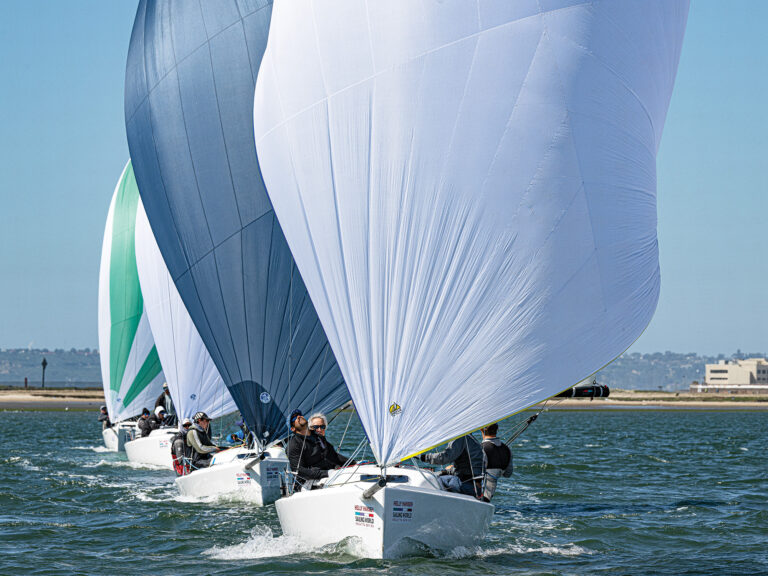
Jim Capron 368
The guy in the “oval office” at US SAILING is temperate, pensive, and unassuming to a fault. Critics say he’s the faceless leader of a faceless organization that is disconnected with the population it is mandated to serve. Behind the scenes, however, the 61-year-old engineer from Annapolis, Md., presiding over the governing body of sailing in the United States, is cautiously leading the organization across a tumultuous sea change to turn this perception around. After years of US SAILING’s reputation being beat down by the influence of specialinterests, an oversized and inefficient structure, unstable finances, and a disenfranchised membership, Capron and his army of volunteers and staff are on the offensive. In March they announced a bold, albeit unwelcome, membership prescription. Capron says this rule is long overdue.The bottom line is that come January 1, 2009, anyone that steers in a race will be required by the Racing Rules of Sailing to be a member. Why this new prescription to the rulebook, and how do you convince the sailors that it’s not just a membership drive or a money grab?I can give you the advertising pitch and list all the things we do at US SAILING, but at the end of the day, we know the individual member will ask, “What’s in it for me?” Now keep in mind that what’s in it for me is different for the offshore sailor, the catamaran sailor, or the one-design sailor. Consequently, there’s no way we can put together a benefits package that will be universally acceptable to everybody. Organizations are mandated to provide services-one-design classes, for example, require you to be a member to race because they have to run an office, keep records, scores, take care of trophies-all of which doesn’t go directly to the member, but to the membership as a whole. Nearly every sailing organization in the world requires the sailor to be a member, to support those services. So the way to do that is to require membership while you’re racing. We’re addressing the competitive sailors, not the recreational sailors.One way to do this is through a rule, and a prescription is probably the best method. The prescription is in the part of the rules that dictate rules while racing. The initial concern was over the types of sailors that one might pick up off the dock for a Wednesday night race; we don’t want somebody to not go racing just because they are not a member, but if you helm the boat, or if you’re the person in charge, we want you to join.Early on, it was to be a more widespread requirement that included any sailor who raced. Why only helmsmen?We still want everybody to join, so we want the skipper of the boat to get all of his crew to be members, which allows them to steer the boat. But we also realize we have to create a rule that is clear and understandable, so it’s unreasonable for us to mandate that everybody be a member if it would be a burden and stop people from going racing.How does this affect collegiate and high school sailors?If we can get a big portion of people joining we don’t have to charge $60 [the current adult membership fee]. What we’d like to do is work with the sailing organizations, at the club level or class level, and certainly at the regional level, to make them partners in this and give them tools to help their members meet this new rule and become members at a lower cost. Likewise with the Inter-Collegiate Sailing Association. The thinking is to help the ICSA meet this rule at a lower-cost membership than they’re currently paying. So it might be lower than their current youth membership, and at the high school level even lower than that. There’s nobody whom I’ve talked to that says you shouldn’t be a member. It’s a no-brainer: if you should be a member, what’s the difference between that and must be a member.Let’s say you the resistance fades and you eventually get a windfall of members; what will you do?We have many demands on our programs for expansion and improvement all the way across the organization. For instance, race administration is one of our key products, so I’d hope to expand our rules training, our judges training, and to get a certified race officer and judge in just about every racing club in the country. The quality and consistency of racing would improve dramatically across the country. We have lots of youth programs and the demands of people asking to send kids overseas to compete, which we’d love to do. We’re holding our costs well and improving our services drastically so we’re getting more efficient, but we can use the help of the membership to have some equality here. For example, we require that our volunteer race officers and judges be US SAILING members, and at midnight when you’ve got the protest hearing going, you might have a sailor on the other side of the table that’s not a member. It doesn’t make sense.What about the perception that US SAILING is disconnected, and that there’s no point in joining?That’s a comment we hear a lot, but the common thing behind this is that people are not aware of what we do. One of the things we always seem to push is what you get for your membership. We always couch it in terms of discounts at marine vendors, or extra insurance, all these tangible benefits, but we found that a major reason why members who do join do so is to support the organization and support the sport. What many people don’t realize is the championships we run, the 25 junior Olympic Festivals, the close to 1,200 race officials we train, update, and support, the 1,200 certificates that we issue, and all the stuff that goes on in the offshore office. There’s a lot of value that doesn’t go into your hands, but it’s something that levels the playing field. It’s part of our job and we’re getting the message out.When you took over the organization back in 2006, what was at the top of your priority list?Finances. There’s a lot of energy in US SAILING, and we jump into a lot of programs because people’s heart and souls are in these programs and requests. Over the years with a large board, these programs would come along and we’d throw money at them without a lot of thought. Consequently, the organization’s finances eroded over the years. So my big push was to flatten out the finances and grow them. Good ideas that come along have to fit our mission, and the board [which was reduced from 49 to 15] has been good about that in the last year and a half. Everything that comes by has to have a good business plan. The other thing we need to do is turn the membership around. We have to be an organization that has a big strong membership base.What else is on your agenda?Improving our championships, and we’re looking seriously into that now. We need to put our resources into certain programs. The judges program is as good as any in the world, maybe the best, and they operate on a shoestring budget, so we need to get them more funding. All we can do is improve the programs that are in good shape right now. Race administration, training and certification are important and they’re high on the list, as is youth development.What are the big challenges then?Getting over this membership hurdle. That’s No. 1, as it has been for years. We can do a better job coordinating the sport, and we can help with sponsorship and funding of our partner organizations. If we can set up a system where people are used to joining the organization and helping us out, it would help solve our brain drain, if you will, and bring down the age of the volunteer pool and bring in some youthful insight. That comes directly from the new membership prescription.









